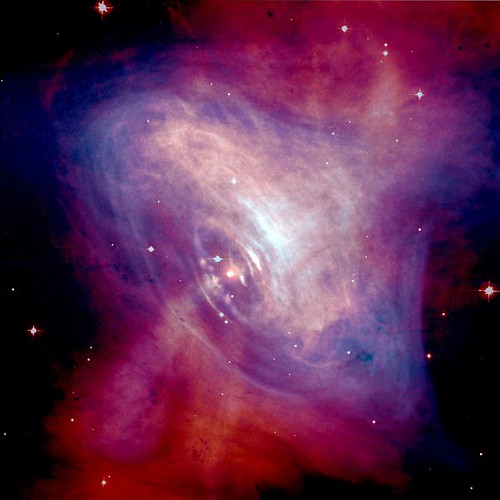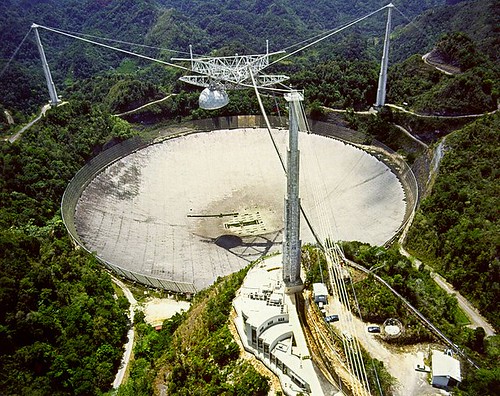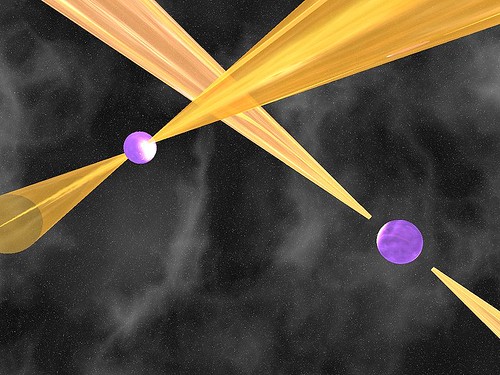Lighthouses in Space
- By Maggie Masetti
- December 28, 2012
- 1 Comment
Since pulsars are something we study here in the Astrophysics Science Division at NASA, and we know it’s a topic people are always curious about, we interviewed astrophysicist Dr. Tod Strohmayer to ask him all about them.
Blueshift: What’s a pulsar? Would you say they look sort of like lighthouses in space?
Tod: A short operational definition is that a pulsar is a spinning neutron star. The pulses that give a pulsar its name are seen each rotation period of the star as a radiation beam generated by the neutron star sweeps across our line of sight to the pulsar.
In that sense they are very much like lighthouses, but unlike terrestrial lighthouses, pulsars can send out beams of X-rays, radio waves, gamma-rays, and maybe even gravitational waves (though those have not been directly detected yet). Some pulsars spin faster than a high-speed kitchen blender! The fastest one currently known spins around 716 times each second. That means that its surface is traveling at about 15% of the speed of light! The scientific term for that is darn fast!
Blueshift: We hear that pulsars have an interesting history – what did early observers think they were?
Tod: The first pulsars were discovered with radio telescopes (radio pulsars), and they currently make up the largest population of known pulsars. The initial discovery was made by a graduate student, Jocelyn Bell! She and her graduate advisor, Anthony Hewish, were so surprised by this very regular, clock-like, pulsing radio signal (the first pulsar had a period of 1.337 seconds) that they thought there was at least some chance that it could be indicative of an extraterrestrial civilization, and they dubbed it LGM-1, for Little Green Men-1.
After other pulsars were discovered it became clear that they were not really little green men, but rotating neutron stars! Only a neutron star could spin as fast as observed and not fling itself apart. When a pulsar was discovered at the heart of the Crab Nebula supernova remnant, the neutron star hypothesis was proved beyond a doubt. A neutron star can be created in the supernova explosion of a massive star.

A composite image of the Crab Nebula showing the X-ray (blue), and optical (red) images superimposed. The size of the X-ray image is smaller because the higher energy X-ray emitting electrons radiate away their energy more quickly than the lower energy optically emitting electrons as they move. X-ray Image: NASA/CXC/ASU/J. Hester et al.
Optical Image: NASA/HST/ASU/J. Hester et al.
Blueshift: How do you look for pulsars? How do you know when you’ve found one?
Tod: There are many ways to look for pulsars because neutron stars manage to emit radiation across almost the entire electromagnetic spectrum. One way is to scan regions of the Milky Way with powerful radio telescopes. The Parkes telescope in Australia has discovered many pulsars this way. It has a good view of the central regions of the Galaxy. The large Green Bank Telescope (GBT) in West Virginia and the huge Arecibo radio dish in Puerto Rico are also pulsar discovery machines.

Aerial View of Arecibo Observatory, Credit: H. Schweiker/WIYN and NOAO/AURA/NSF
A very interesting class of X-ray pulsars can be found by looking for new X-ray stars in the sky. These accreting pulsars are gaining mass from their close binary stellar companions. When they gobble up this matter these neutron stars can become powerful X-ray sources and can be observed using orbiting satellites with X-ray sensitive telescopes. The accreted material also imparts a “kick” to the neutron star, making it spin faster and faster. We think this is how the fastest spinning pulsars acquired their record speeds.
There are a variety of indications that let you know you’ve found a pulsar. One is as simple as you can go back and find it again at the same place on the sky, pulsing at the same period. In other cases, when pulsars are in a binary system with another star, measurement of the pulses lets you map the star’s orbit very precisely. Then there is little doubt you have found a pulsar.
Blueshift: What can you learn from observing pulsars?
Tod: Because pulsars are such precise clocks – a neutron star is the biggest “flywheel” that you could ever hope to find – you can do some pretty amazing “experiments” with them. Indeed, pulsars have won Nobel Prizes for more than a few astrophysicists!
For example, pulsars have been used to test Einstein’s theory of General Relativity. The orbital period of the famous “binary pulsar” (PSR 1913+16, a pulsar in an 8 hour binary with another neutron star) is decreasing ever so slightly, but at a rate which exactly matches Einstein’s prediction due to the loss of gravitational radiation from the system. This discovery earned Joseph Taylor and Russell Hulse the 1993 Nobel Prize in Physics!
The “double pulsar” (PSR J0737-3039) is perhaps even more amazing, as it hosts not one but two pulsars in a binary system! It has also been used to test General Relativity, and its pulsars have been weighed with extraordinary precision (they are 1.338 and 1.249 times the mass of the Sun).

Artist’s impression of binary pulsar PSR J0737-3039. These two pulsars orbit around the common center of mass in 2.4 hours. The faster rotating pulsar spins 45 times per second or almost 3000 times per minute. In the same time, the slower rotating pulsar spins only 22 times or every 2.8 seconds. Credit: Michael Kramer (Jodrell Bank Observatory, University of Manchester)
Blueshift: What makes them cool? Why do you study them?
Tod: For me pulsars are cool because they provide a way to observe neutron stars, which are – in my admittedly biased opinion – perhaps the most amazing objects in the universe. A neutron star can be more massive than the Sun but is only as big as a city. It contains matter at the highest densities we know of in the universe. They also have the strongest known magnetic fields. A sugar-cube-sized bit of neutron star core material would weigh about 1 billion tons! We still don’t know exactly what that stuff is and its physical properties. Studying neutron stars may let us figure that out.
One way to do that is to measure both the mass and size of neutron stars with high precision. Because they are so small compared to other stellar objects measuring their size accurately is very tricky. Probably the best way to do that is to observe X-ray emission from their surfaces. That’s one reason I study X-rays from neutron stars.
So, a neutron star is sort of like the most extreme science lab you could ever hope to find, and that’s pretty cool.
Blueshift: What’s the weirdest (or perhaps most interesting?) pulsar you’ve observed?
Tod: Accreting neutron stars can also produce spectacular thermonuclear explosions called X-ray bursts. As the matter (mostly light elements like hydrogen and helium) piles onto the neutron star it is heated and compressed and can erupt in a burst of nuclear fusion. The energy produced would be like exploding 100 large (15 Megaton) hydrogen bombs over every postage-stamp-sized area of the neutron star’s surface!
Some of these bursting neutron stars are nuclear powered pulsars! The nuclear fusion can heat the surface unevenly, and as the star spins we can see these “nuclear hot spots” rotating in and out of view. Rarely (once a year, or less), a neutron star may produce a “superburst,” an X-ray burst that can last for several hours!
One of the most interesting pulsars I’ve ever observed was one of these nuclear powered pulsars seen during a “superburst.” The pulsar in this object (called 4U 1636-53) is rotating about 582 times per second. The pulsar was detected for about 13 minutes, during the peak of the “superburst,” and it was just long enough to measure the neutron star’s orbital speed. I don’t know if weird is the right term, but it was interesting, both because it was pretty much unexpected, and you have to have some serious luck to actually catch one these rare superbursts in the act!

This animation illustrates a thermonuclear explosion as it ignites, spreads, and engulfs an entire neutron star. Credit: NASA
Blueshift: Thanks, Tod!
Before we go, we’ll leave you with one more cool thing about pulsars. Tod told us this story: “When I was a graduate student I visited Arecibo observatory with some radio pulsar observers. I mostly tried to stay out of the way and learn whatever I could. It was a lot of fun, and I used some of the data in my doctoral thesis. One of the observers, Tim Hankins, liked to hook up the radio telescope’s receiver output to a loudspeaker, and you could literally hear the pulsars thumping away! That was pretty cool.”
(In case you’d like to hear that, visit this page and listen to a pulsar yourself!)



Iloved the video of the massive neutron star.The sound produced by the magnetic field reminded me of my mothers old kerosine washer from the late 1950’s.The neutron star sounded very angry.How did you manage to capture sound so far away in the crab nebula.